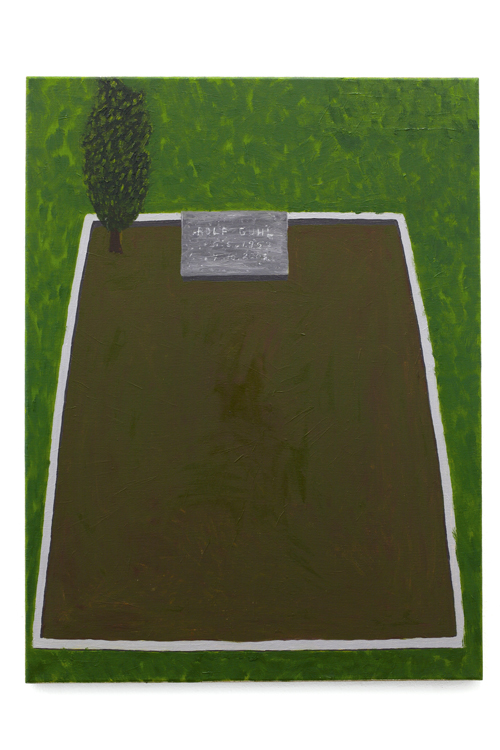Leidy Churchman
Ab-Ex clichés, living canvases and graveyards
Ab-Ex clichés, living canvases and graveyards

‘You cannot hang an event on the wall, only a picture’, remarked Mary McCarthy in her review of Harold Rosenberg’s influential volume of essays The Tradition of the New (1959). She was referring to Rosenberg’s The American Action Painters (1952), in which he casts the canvas as an ‘arena in which to act’: ‘what was to go on the canvas was not a picture but an event’. Approaching Leidy Churchman’s work via such a digression may seem inappropriate if one considers Rosenberg’s contribution to establishing the enduring clichés about Abstract Expressionism: fetishization of the (male) gesture and existentialist pathos. Nothing could be further removed from Churchman’s painterly praxis, which positions bodies in a wide range of subject-object constellations and makes them just as much part of the form-finding process as the painting itself.
In his Painting Treatments videos (2009 and 2010), Churchman performs painterly actions recalling spa treatments on friends, never specifying whether painting is being subjected to a treatment here or the participants are. They lie, sit or crouch alone or in groups on the white studio floor, some naked, some clothed, usually covered with towels, cloths or newspapers. Branches, books and building bricks are then arranged on these ‘living canvases’; potatoes, breakfast cereals and snow are poured over them; they are sprinkled with flour, ground coffee and various liquids. Paint is applied, rubbed in, dabbed on and banged in with brushes, ladles, mops and tape dispensers. The bodies ‘treated’ in this way lead a curious double existence: although immobilized in their role as picture supports (one scene recalls an autopsy), they nevertheless have a life of their own: someone has a smoke, a couple hold hands, a dropped bar of soap is politely returned.
Painting Treatments suggest that Abstract Expressionist vocabulary and bodies can be examined afresh; perhaps the ‘power of transformation’ Rosenberg saw in painting can be attributed to Churchman’s praxis. This reading applies not only to his video works, which by definition possess a certain ‘event character’, but also to what are probably the artist’s ‘quietest’ paintings to date: a 2011 series depicting graves. Contrary to one’s expectations, the pictures are neither morbid nor dark but depict the graves as peaceful, charming places lying in the landscape like carefully-made beds. In spite of their quasi-naive rendering, the pictures perform complex compositional manoeuvres: with their formal rigour, the memorial stones, grave enclosures and floral decorations have an anti-spatial effect, tending towards flatness as geometrical figures and fields of colour. This effect is manifest most drastically in Here: the final resting place of Rolf Guhl (according to the inscription) has a grey border and is decorated by a disproportionately small tree which stands in the otherwise monochrome brown surface. The grave – embedded in the green meadow, with no horizon – effectively becomes a signed painting within the painting: an ambiguous figure caught between figuration and abstraction, between pictorial space and picture plane.
In these works, the question of the relationship between the body and the painting is addressed far less explicitly than in the videos. Yet the body is present here, too: as a motif implied by the deceased’s name and years of birth and death, as a reason for the burial site, the headstone and the floral borders, and indirectly for the painting itself. As in Painting Treatments, the body – gently covered with a layer of paint – seems to shine through the composition and unsettle the picturesque landscape. Once one has seen the body, it cannot be ‘unseen’.
In his foreword to the second edition of The Tradition of the New (1960), Rosenberg is prompted by McCarthy’s admonition to ponder the ‘activity’ of painting outside the studio: ‘The Bolshevik Revolution may have turned into a picture on the wall, but it was a picture that pulled the entire globe into it, and even outer space. No room was left for the spectator who merely looks, as there was in the days when the earth had empty spots and the heavens were full.’ Although Rosenberg had an entirely different kind of picture in mind when he wrote these lines, I feel this same ‘pull’ in all of Churchman’s painting – a pull towards more than mere contemplative looking.
Translated by Nicholas Grindell
















